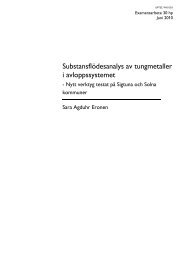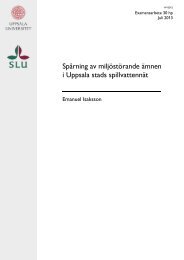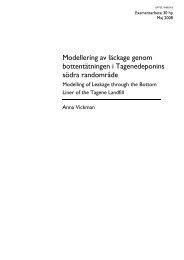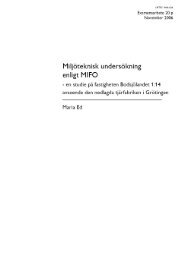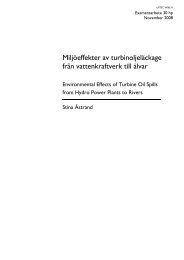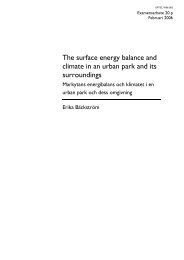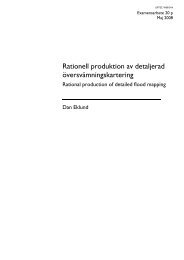Nutrient Transport Modelling in the Daugava River Basin - DiVA Portal
Nutrient Transport Modelling in the Daugava River Basin - DiVA Portal
Nutrient Transport Modelling in the Daugava River Basin - DiVA Portal
Create successful ePaper yourself
Turn your PDF publications into a flip-book with our unique Google optimized e-Paper software.
<strong>the</strong> chosen value is a very rough approximation. The value of ra<strong>in</strong>fall erosivity islikewise an approximation and <strong>the</strong> sediment delivery ratio is an extrapolation s<strong>in</strong>cevalues were not given for watersheds as large as <strong>the</strong> <strong>Daugava</strong> bas<strong>in</strong>. All toge<strong>the</strong>r, <strong>the</strong>predicted erosion may be considerably erroneous. Never <strong>the</strong> less, a more probableexplanation for <strong>the</strong> underestimation of phosphorus loads is that <strong>the</strong> reported values ofpo<strong>in</strong>t source phosphorus loads <strong>in</strong> <strong>the</strong> bas<strong>in</strong> are a lot less than <strong>the</strong> actual value and thatphosphorus from septic systems, which are not <strong>in</strong>cluded <strong>in</strong> <strong>the</strong> modell<strong>in</strong>g, contributessubstantially to <strong>the</strong> total load. Accord<strong>in</strong>g to HELCOM (2004b), about 70 % of diffusephosphorus loads to <strong>the</strong> Gulf of Riga orig<strong>in</strong> from o<strong>the</strong>r sources than agriculture andforestry, for <strong>in</strong>stance from septic systems. Look<strong>in</strong>g at <strong>Daugava</strong> <strong>the</strong> figure is probablysometh<strong>in</strong>g similar s<strong>in</strong>ce water from <strong>the</strong> <strong>Daugava</strong> is <strong>the</strong> ma<strong>in</strong> contributor to <strong>the</strong> Gulf ofRiga. Gren et al. (1997) state that <strong>the</strong> lack of sewage treatment <strong>in</strong> <strong>the</strong> Gulf of Rigaregion contributes to very large <strong>in</strong>put of phosphorus to <strong>the</strong> sea. S<strong>in</strong>ce agriculture andforestry are <strong>the</strong> ma<strong>in</strong> sources of phosphorus accord<strong>in</strong>g to <strong>the</strong> model and s<strong>in</strong>ce septicsystems are not <strong>in</strong>cluded it is <strong>the</strong>refore not surpris<strong>in</strong>g that <strong>the</strong> model fails to predictphosphorus loads.An <strong>in</strong>dication of po<strong>in</strong>t source phosphorus pollution is that concentrations are higher atlower flows and lower at higher flows. In figure 11 <strong>the</strong> observed phosphorusconcentration and streamflow are displayed.Stream flowPhosphorus concentrationStreamflow (cm/month)1210864200.140.120.10.080.060.040.020Phosphorus concentration (mg/l)Apr80Apr81Apr82Apr83Apr84Apr85Apr86Apr87Apr88Apr89Apr90Apr91Apr92Apr93Apr94Apr95Apr96Apr97Apr98Apr9919802000.Figure 11. Reported streamflow and phosphorus concentration,It seems like <strong>the</strong> peaks <strong>in</strong> phosphorus concentration occur at low flows which could bean <strong>in</strong>dication of po<strong>in</strong>t sources of phosphorus, but <strong>in</strong> order to say someth<strong>in</strong>g def<strong>in</strong>itelyone would need to conduct a statistical analysis of <strong>the</strong> two time series.Of <strong>the</strong> parameters used <strong>in</strong> <strong>the</strong> sensitivity analysis <strong>the</strong> nitrogen concentration <strong>in</strong>groundwater box 1 is <strong>the</strong> one that affects average loads <strong>the</strong> most. This is not surpris<strong>in</strong>gs<strong>in</strong>ce streamflow ma<strong>in</strong>ly consists of water from groundwater box 1. It is <strong>the</strong>reforeimportant to calibrate this parameter carefully. The impact of <strong>the</strong> recession coefficientsand <strong>the</strong> coefficient determ<strong>in</strong><strong>in</strong>g flow between <strong>the</strong> two groundwater boxes appears to bevery small, look<strong>in</strong>g at <strong>the</strong> result of <strong>the</strong> sensitivity analysis. The reason for this is <strong>the</strong>small difference between <strong>the</strong> nitrogen concentration <strong>in</strong> <strong>the</strong> two boxes (1 and 1.3 mg/l,respectively). With a more pronounced difference <strong>in</strong> concentration between <strong>the</strong> boxes<strong>the</strong> impact on <strong>the</strong> nitrogen load of <strong>the</strong> recession coefficients and <strong>the</strong> coefficientdeterm<strong>in</strong><strong>in</strong>g flow between <strong>the</strong> two boxes would have been greater.20



